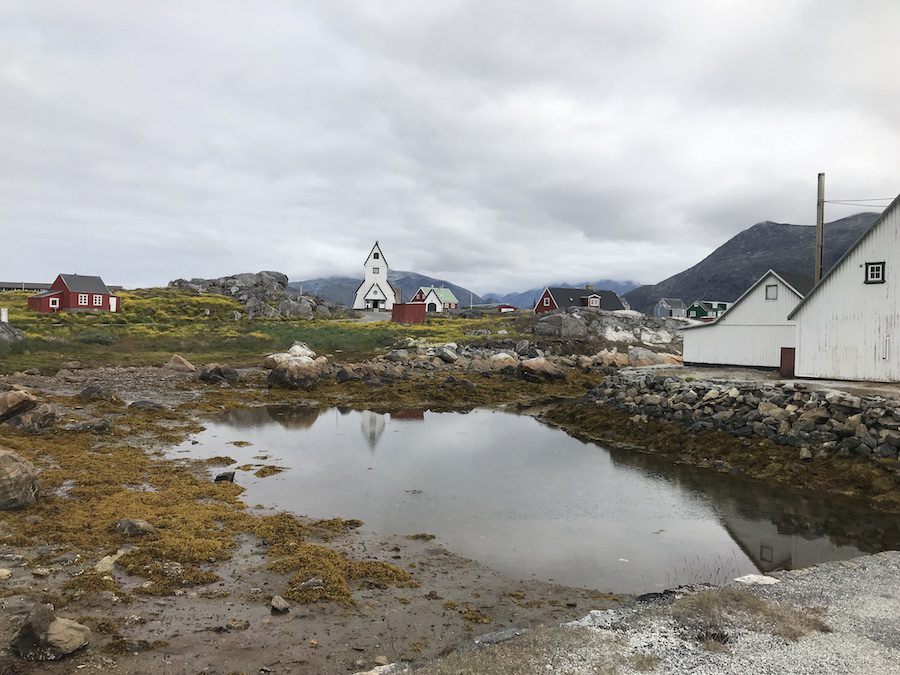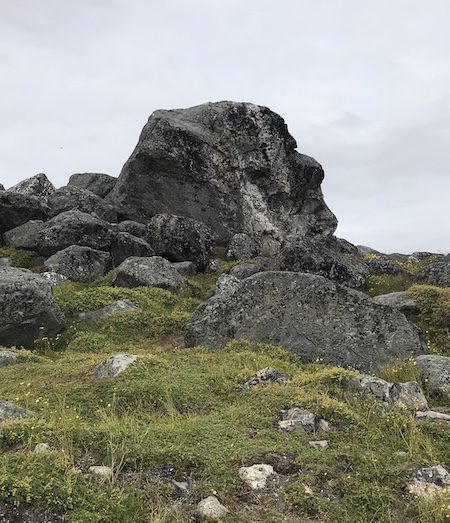As Oceania Insignia neared Tasermiut Fjord, Southern Greenland, Anne and Vera disembarked at their first port on Greenland in the town and island of Nanortalik (meaning Place of the Polar Bears). Join them as they discover some of Greenland’s culture, exploring it southernmost town.
Greenland had seemed like such a strange and mysterious land before I travelled there, and I had sometimes wondered if anyone even lived there. I found out that not only did people live there, but many of the towns were cruise ports that welcomed tourists.

As we came into the harbour of our first cruise port of Nanortalik, from a distance we could already see the colourful houses that seemed to be a trademark of Greenland towns. They were scattered throughout the town and up the hillsides, and all seemed to have a lovely water view of the harbour. They created such a picturesque image, almost like something from a children’s storybook.

We later learned that the colours mean certain types of buildings – for example yellow for medical buildings, blue for fish factories, and red for churches, stores, and schools – including the homes of people who work in those particular jobs. This had apparently made it easier for people to find the building they wanted before there were street names, but now it is more because they like how pretty it makes their towns look.

Nanortalik is a quaint little town of only about 1000 people. As we wandered down the quiet ‘main’ street, we passed by a few local people selling small items by the roadside. These were Inuit people displaying their handmade beaded or carved goods. Most of these Inuit did not speak English, but we found that shop employees generally could.

There were only a few small stores, and we wandered into some to look around. As we browsed in the only grocery store and pharmacy in town, we noticed that prices for many things were higher than back home. Many items on the shelves were familiar to us, but as we stopped at the freezer section we exclaimed over the unfamiliar meats such as whale, seal, and reindeer.
Most store employees spoke some English, and most of the locals were friendly. We learned that the majority of people in Greenland welcome tourists and the economic benefits to their towns, but one fellow at a tiny market proved to be an exception. He must have seen us taking a photo of a particularly colourful purple store, because as we were approaching his market he came out and proclaimed, “Five dollar for a photo”. When we realized he was not joking, we smiled and continued down the road.

Along the way we passed by two of the places of interest for this town. The first was a lovely, historic Lutheran church – the only church in town. With its tall and unique-looking structure, it was so lovely with the mountains, water, and the rest of the town in the background. We took some photos and decided to go inside on our way back.

Right across from the church was the second place of interest – the ‘Knud Rasmussen Stone’. It is a large rocky boulder, carved naturally by the forces of nature, and it appears to resemble the face of the polar explorer, Knud Rasmussen. He was one of the founders of the Nanortalik area of Greenland, the first to cross the ice-covered Northwest Passage by dog sled, and he spent many years going on expeditions to learn about Greenland and its people.
A short ways up, at the end of this road, was the main attraction we had been heading to see – the Nanortalik Open Air Museum. This was a collection of several authentic, rustic-looking buildings housing many different aspects of the history of the area. There were ones with Inuit fishing and hunting tools, kayaks and umiaks, snowshoes, clothing, food, and ornamental items. Other buildings showed the Viking way of life, and as we read some of the information there, we were appalled at how barbaric they had been. There had certainly been no equality among the Viking men and women, and particularly between husbands and wives!



Outside of the buildings was a lookout area, with a lovely view of the fishing harbour, including a few remnants of icebergs. My fearless sister, who is five years older than me, climbed up a narrow flag-pole stairway to get even more of a panoramic view, while I was content to wander the grassy slopes below.

Then as we made our way back, we again came to the pretty church. Going inside this time, we found it to be absolutely beautiful. It was the perfect setting for some peaceful, quiet moments to reflect and say a prayer.


Carrying on, we went to look at the fishing boats in the small marina and then wandered back through town, stopping to look at views and interesting sights along the way, before returning to the cruise ship.

Tips & Recommendations for Exploring Nanortalik:
- The Nanortalik Open Air Museum is worth visiting and costs $10 US per adult.
- Bring local currency Danish Krone (DKK) or US dollars in small bills for the museum entrance and other small purchases. Some stores do not give change for USD.
- Wear or bring some cold weather coats, hats, scarves and mittens as it was chilly in the Greenland ports, even during the middle of August.
- Looking for places to stay in Nanortalik? Checkout these Nanortalik Accommodation suggestions on TripAdvisor.

Tune In To Our Full Adventure With Oceania Insignia’s ‘Atlantic Glaciers and Harbors’ Cruise
- Reykjavik, Our First Port in Iceland
- Grundarfjordur and Iceland’s Snaefellsnes Peninsula, Our Second Port in Iceland
- Icelandic Island of Heimaey, Our Third Port in Iceland
- Cruising from Iceland to Greenland with Oceania Insignia
- Paamiut, Wandering Around this Southwest Greenland Port
- Qaqortoq, Discovering a Taste of Greenland
Disclaimer: There are affiliate links in this post. If you make a purchase after clicking on one of these links, we may receive a small commission at no extra cost to you. This commission contributes to paying our writers for their storytelling. We only post links to things that we ourselves have tried.




We are on the Oceania Marina visiting Greenland and Iceland in July-August. We have been looking at their shore excursions and have concluded most can be done on your own. Any you recommend that can’t and are worthwhile?
We are going through the Maritimes with the same issues.
Hi Tom,
We liked the ship excursions like ‘The Taste of Greenland’ in Qaqortoq and ‘Iconic Towns of Nova Scotia’ in Halifax, but our favourites were the ones I had booked independently like ‘Snaefellsnes Peninsula’ at Grundarfjordur, ‘Puffins & Volcanoes’ on Heimaey, and ‘Ollie’s Trolleys’ at Bar Harbor.
You can find more detailed information on all our excursions in my blogs on Iceland, Greenland, and the Maritimes.
Hope this helps.